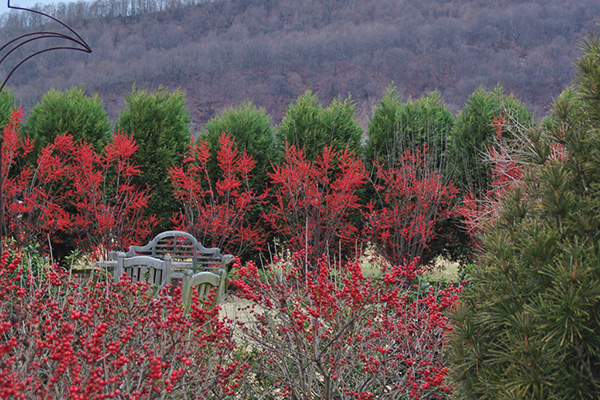
Native Delaware: Winter interest
Noted garden designer Colston Burrell to speak at UD Feb. 26
11:57 a.m., Feb. 7, 2013--Colston Burrell spent 11 years in Minnesota, none too happy with the winter weather. A noted garden designer, Burrell tried to make the best of his “six months of winter confinement.” He liked the view of deep snow outside his windows and the patterns that frost made on Joe Pye weed and other stalks in his prairie garden. Still, winter was something to be endured.
But a funny thing happened when this Richmond, Va., native returned to the Mid-Atlantic. That first autumn in his new home, near Charlottesville, he watched the leaves fall and felt a sense of dread. But once the cold weather arrived, he realized he had come to appreciate the subtleties of the winter landscape.
Campus Stories
From graduates, faculty
Doctoral hooding
“Here in the Piedmont region of Virginia, winter means fields of broomsedge that look golden in the late afternoon sun, contrasted by the greens of juniper and other coniferous trees,” said Burrell. “It’s berries on shrubs like viburnums and hollies, texture from interesting barks, and catkins on native hazels and alders.”
And in Virginia, and often here in Delaware, too, it can mean days when temperatures rise into the 40s and 50s and Burrell can linger in the garden to enjoy the fragrance of daphne and the flowers of the precocious hellebores that he so loves. (He wrote a book about hellebores, which bloom as early as mid-January in Delaware.)
“Today, I won’t be lingering in the garden,” declared Burrell on a late January morning when the temperature was just 11 degrees. But, from the window of his home office, he could still view the fruits of winterberry hollies and the shimmering plumes of silver plume grass. That was no accident. When Burrell designed his home landscape he put some plants with winter interest where they could be seen and enjoyed from inside the house.
Burrell will speak about “Design Ideas and Plant Combinations for Winter Gardens” on Tuesday, Feb. 26, in Newark. His talk is sponsored by the University of Delaware Botanic Gardens. An active lecturer, Burrell has spoken at Winterthur Museum and Longwood Gardens but “hasn’t been to Delaware in quite a while,” he said.
If you go, expect plenty of audience interaction. “I don’t want to suggest a particular plant and then disappoint people when they discover it doesn’t grow well in their region,” said Burrell. “But if someone from the audience can say, ‘Yes, I’ve grown that here for 50 years and never had a problem,’ then we know my recommendation is appropriate.”
Burrell plants mostly natives on his 10-acre property but he does make an exception for “precocious bloomers.” He craves flowers and fragrance in the dead of winter and uses non-native hellebores, crocus, snowdrops, winter aconite and glory-of-the-snow for an early taste of spring.
But natives offer winter interest, too. Early in the season, Burrell enjoys beautyberry’s purple or lilac berries, which brown after a hard frost. Winterberry starts displaying its vivid red berries in late autumn and they hang on through the winter. (The berries are bitter, so overwintering birds avoid them until other food sources are gone.)
American holly, with its bright red berries, is another good choice for jazzing up the winter landscape. Just don’t plant any of these shrubs in a long, monotonous row, said Burrell. Instead, consider grouping American hollies in clusters. Beautyberry is striking enough to work well alone, as a specimen planting.
Many gardeners use evergreen trees to offset winter’s monochromatic palette. But fewer gardeners turn to evergreen groundcovers for a pop of color. Burrell likes the texture and form of many evergreen groundcovers, including Pachysandra procumbens “Allegheny Spurge.”
This easy-to-grow native has medium- to dark-green leaves during the growing season that become dappled or bronzed in winter. And when the cold weather is just a memory, tiny, pinkish white flowers appear on Allegheny Spurge.
Other evergreen groundcovers well suited to Delaware include Christmas fern (good for areas of light to deep shade), barren strawberry (which looks better than the name implies), and partridgeberry, a slow-grower which never exceeds 3 inches in height.
UDBG talk
At the Feb. 26 talk, Burrell will speak about “Design Ideas and Plant Combinations for Winter Gardens” at 7 p.m. in Townsend Hall at the University of Delaware. Cost is $15 for members of UD Botanic Gardens Friends; $20 for the public. To register, call 831-2531 or email botanicgardens@udel.edu.
Article by Margo McDonough
Photo courtesy of C. Colston Burrell








